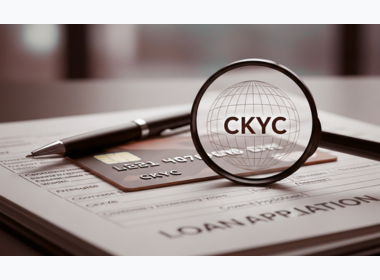Search Suggestions
- Gold Loan
- Money Transfer
- Mutual Funds

Debt-Service Coverage Ratio (DSCR): Meaning, Formula & Real-World Uses
DSCR is a financial tool that determines a firm's potential to fulfil its debt commitments. It differs from generic metrics, as it provides a precise calculation with significant strategic value. Apart from evaluating the company’s health, it also aids in the process of decision-making related to investments and borrowing. To understand this in depth, let’s explore what DSCR is, its significance and how it can help you make your financial decisions.
Table of Content
- What is the debt-service coverage ratio?
- What is the debt-service coverage ratio formula?
- Components of the Debt-Service Coverage Ratio
- Importance of DSCR in financial management
- What is a good debt-service coverage ratio?
What is the debt-service coverage ratio?
The full form of DSCR is Debt-Service Coverage Ratio. DSCR determines the capacity of an entity to generate sufficient cash flow to cover its loans. Further, understanding how to calculate the debt service coverage ratio is essential for evaluating a borrower’s ability to repay debt through operating income.
You can calculate the company's income by dividing it by the total loan service (interest and original payment). A DSCR above 1 means that the entity generates enough income to comfortably meet its loan repayments, or strong financial health. Conversely, a DSCR below 1 implies that the firm may face challenges in fulfilling its debt obligations. One of the benefits of the debt service coverage ratio is that it helps lenders assess the financial stability and repayment capacity of a borrower.
What is the debt-service coverage ratio formula?
Below is the formula for calculating DSCR:
DSCR = Total Operating Income/Total Debt Service
- Total Operating Income (TOI): It refers to income earned from primary business operations, which do not include interest expenditure or income tax.
- Total Debt Services (TDS): This includes all necessary loan payments, such as both principal and interest amounts.
A good debt service ratio for personal loan applications can improve your chances of loan approval and better terms.
Components of the Debt-Service Coverage Ratio
The DSCR calculation involves two key inputs:
- Net Operating Income (NOI): It is the remaining income after deducting operating expenses from total revenue, except for interest and tax costs. The ratio typically aligns with a firm’s Earnings Before Interest and Taxes.
- Total Loan Services (TDS): This includes the company’s loan-related payments within a year, such as major repayment, interest expenses, lease obligations, and sinking fund contributions. It is responsible for the outstanding parts of both short-term lending and long-term loans, as shown on the balance sheet.
Suggested Read: How to Choose Between a Short-Term and Long-Term Gold Loan
Importance of DSCR in financial management
Management of risk
Beyond assessment, the DSCR serves as an early warning system for potential financial distress. Financial managers can use this ratio to identify situations where operating income does not cover loan payments.
Informed credit
Financial managers use DSCR to assess new loan opportunities by determining how well the organisation can manage extra financial responsibilities. The ratio provides financial managers with a clear understanding of how borrowing decisions affect the company's ability to repay debts and maintain financial stability.
Building Credibility with Lenders and Investors
A strong DSCR indicates financial reliability, making it a major metric for lenders and investors. A positive ratio indicates that the company may handle its annual debt obligations, leading to better debt terms and boosting confidence with stakeholders.
Strategic financial planning
The DSCR provides a clear approach to the company's financial position, which helps shape well-informed strategies. The ratio supports making effective financial decisions, whether it is the development plan or management during uncertain economic times.
Performance benchmarking
Financial managers can evaluate their debt management efficiency by tracking DSCR over time or comparing it to the industry average. This comparison helps improve the ability of the organisation to refine strategies and serve your loan.
What is a good debt-service coverage ratio?
DSCR above 1
A DSCR above 1 indicates that the organisation is generating more income than required to meet its loan payment. This surplus reflects strong financial health and reduces the possibility of default.
Industry standards
The acceptable DSCR level depends on the industry sector. The level of financial risk varies between different industries, so you should compare your DSCR to industry-specific standards for accurate evaluation.
Lender requirements
The minimum DSCR threshold serves as a standard that lenders use to evaluate loan applications. The DSCR ratio needs to be at or above these thresholds to obtain favourable financing terms.
Project-specific factors
A high DSCR is usually preferred for new investment or development projects to provide a buffer against unexpected challenges. The ideal ratio may vary depending on the nature and risk of the project.
Financial strategy
Businesses select high DSCR values when they want to maintain financial stability through risk reduction. The ratio works for businesses with low DSCR when their growth plans and risk tolerance match this approach. Before applying for a personal loan, it’s important to evaluate your income and expenses to ensure you meet the lender’s eligibility criteria.
Bottom Line
Accurate DSCR calculation serves as a critical factor for enhancing financial assessment and credit analysis and strategic decision-making. The calculation provides stakeholders with a precise data-based understanding of an organisation's debt repayment capabilities. The widespread use of DSCR calculations requires accurate calculations to evaluate creditworthiness and make investment decisions.
- Apply PAN Card Online
- Application
- Eligibility
- Documents Required Forms
- Form 49A
- Form 49AA
- Fees
- Correction & Update
- NRI PAN Card
- Tracking
- Penalty
CATEGORIES
OUR SERVICES
-

Credit Score
-

Gold Loan
-

Personal Loan
-

Cibil Score
-

Vehicle Loan
-

Small Business Loan
-

Money Transfer
-

Insurance
-

Mutual Funds
-

SME Loan
-

Corporate Loan
-

NCD
-

PAN Card
-

NPS
-

Custom Offers
-

Digital & Cashless
-

Milligram Rewards
-

Bank Mapping
-

Housing Finance
-

#Big Business Loan
-

#Gold Loan Mela
-

#Kholiye Khushiyon Ki Tijori
-

#Gold Loan At Home
-

#Sunherisoch
RECENT POSTS

Why Are Gold Loans the Best Option When Banks Reject Your Personal Loan?
Know More
Struggling with low CIBIL? Here’s How a Gold Loan Can Still Get You Funded
Know More
What is a Top-Up Loan? Eligibility Criteria Explained
Know More
Top Factors That Influence Mortgage Loan Interest Rates
Know More
What is a Loan Against Mutual Funds and How Does it Work?
Know More
What is Working Capital? Meaning, Formula & Importance
Know More
Understanding KDM Gold and Why it’s Banned
Know More
Gold loan boom: 3,000 new branches to open in India in 12 months
Know More
Gold Loan Boom: Rs 14.5 lakh crore market spurs NBFCs to add 3,000 branches
Know More
How BNPL Affects Your Credit Score
Know MoreFIN SHORTS

What Are Co-Pay and Deductibles in Insurance Policies?
Know More
Should You Take a Loan Against Your Mutual Fund or SIP?
Know More
Top 5 Best Mid-Cap Mutual Funds to Watch in 2026
Know More
Are Personal Loans Right for Retirees? Key Points to Consider
Know More
What Happens to a Personal Loan After the Borrower Dies?
Know More
Best Loan Choices for Credit Scores of 580 and Below
Know More
7 Reasons Why a Gold Loan Is the Best Option for Small Businesses
Know More
10 Reasons Why People in India Prefer Physical Gold
Know More
Real Estate vs Gold: Which Is a Better Investment in India?
Know More
10 Common Mistakes That Make Investors Lose Money in Mutual Funds
Know More
10 Reasons Why Gold Has So Much Appeal in Uncertain Times
Know More
7 Ways Settling Debt Can Impact Your CIBIL Score
Know More- South +91 99469 01212
- North 1800 313 1212





